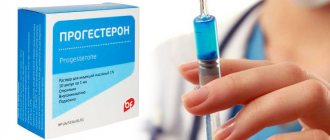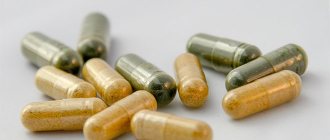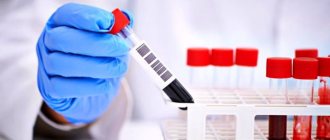Causes and signs of low progesterone
There are many factors that contribute to a decrease in sex hormones. Most often these are pathologies of the genitourinary system, the use of drugs, including contraceptives. Poor nutrition and stress can affect the decrease in progesterone. If you notice that you have become irritable, have chronic fatigue and sudden mood swings, then you should go to the clinic for a blood test. In addition, characteristic symptoms of low progesterone will be excess weight, headaches, and swelling of the mammary glands.
How is the level determined?
Progesterone levels are determined quite easily using a blood test. In the early stages, as a rule, the study is carried out only when indicated, if the doctor has any suspicions. In a normal pregnancy, a test to determine progesterone levels is carried out in the third trimester.
Diagnostic procedures are usually carried out in the morning. A prerequisite is that the analysis is taken on an empty stomach. If a woman has eaten, at least six hours must pass. Only after this is it allowed to take tests. Otherwise, the reliability of the result is called into question.
In addition, the doctor strongly recommends that you stop taking hormonal medications two days before the expected date of the study, and also eliminate stress. It is not recommended to smoke cigarettes several hours before taking blood.
The role of progesterone
Progesterone is a hormone that belongs to the group of neurohormones. It affects reproductive function and sexual development. The functions of progesterone are as follows:
- Responsible for the production of sperm and the male steroid called testosterone.
- Responsible for slimness. If its concentration in the blood is reduced, this leads to excess weight.
- It is progesterone that influences the second half of menstruation and the ability to conceive a child. It thickens the walls of the uterus and relaxes it.
- Affects the development of the placenta and the maintenance of pregnancy until delivery.
Norms
There are certain standards for progesterone levels in the blood.
In the first two weeks of the cycle, the body of the expectant mother contains approximately 1-1.5 n/mol of progesterone. Over the next two weeks, hormone production increases to 2 n/mol. Increasing the level of content stimulates the woman’s reproductive organ to accept the egg. After its successful attachment, progesterone production increases significantly by 3-29 n/mol per day. In the early stages, the level of the hormone in a woman’s blood is at least 12 ng/ml. By the end of the third trimester, a woman’s body should contain at least 172 ng/ml of progesterone.
The level of the hormone in the blood undergoes significant changes over time. The closer the date of expected birth, the higher the level of progesterone in the blood of the expectant mother.
Products that increase progesterone
To balance the hormonal levels in a woman’s body, you need to follow a properly formulated diet. The essence of rational nutrition is the required ratio of the concentration of proteins, fat and carbohydrate foods, and sufficient fluid intake.
What foods increase progesterone in women:
- beans, lentils, peas;
- nut;
- dairy products;
- lean meats (chicken and turkey fillet, young veal, rabbit), and also liver;
- chicken and quail egg (mostly yolk);
- oatmeal, whole grain cereals, flax seed;
- avocados, black, raspberries and green olives.
These products do not contain progesterone. When consumed, it is possible to stimulate the body’s synthesis of its own hormone. Cholesterol is needed to activate this process. For this reason, it is important to add egg and meat dishes to your diet, as well as foods rich in vitamins E and P - potatoes, rose hips, fruits and fish.
Avoid eating foods in plastic packaging. According to research, such a container leads to the penetration of xenoestrogens into food, which suppress the process of progesterone production. Plastic containers are produced using bisphenol. This substance accumulates in the body and subsequently has an estrogen-like effect, leading to infertility and disruption of menstrual cycles.
To protect the body from the harmful effects of bisphenol, do not place food in the microwave for heating using a plastic container. It is necessary to replace plastic dishes with glass, steel or ceramic ones.
It is possible to increase the concentration of progesterone only on the condition that, in addition to taking these products, the man or woman avoids stress, excessive psycho-emotional and physical stress, and receives as many positive emotions as possible.
Ortilia lopsided
A ready-made infusion of ortilia can be purchased at pharmacies in your city, or you can prepare it yourself at home. To prepare the tincture, you need to take 50 grams of ortilia and pour half a liter of vodka into it. Place the mixture in a cool, dark place and store for no more than 2 weeks. The tincture should be taken 30 drops half an hour before meals three times a day.
It is recommended to start taking all tinctures from the plants described above after the ovulatory phase, while during menstruation you need to pause and not use them. In addition, it is forbidden to drink infusions together with herbs such as mint, licorice, red clover due to the fact that these plants have the opposite effect and help reduce progesterone.
Increasing hormones with folk remedies
You can increase the concentration of progesterone by consuming herbal infusions. They contain or stimulate hormone synthesis in the body. The most effective are
- common twig;
- ordinary cuff;
- plantain;
- wild yam;
- raspberries;
- chaste vitex;
- Potentilla gossamer;
- meadow lumbago.
They must be taken from the 15th to the 25th day of the cycle. If the decoctions were prepared correctly and the dosage was followed, the concentration of progesterone will increase.
Popular recipes
- Take 40 g of raspberry leaves, pour 200 ml of hot water over them. Wait 1 hour. Filter the cooled broth and then consume it in small portions throughout the day.
- Place raspberry leaves and wild yam in equal quantities into a container. Moreover, it is best to use dry raspberry leaves. Then take 20 g of raw material and add 200 ml of boiling water. Wait 203 hours, cool, filter, and then take 20 ml 3 times throughout the day.
- Plantain seeds – 10 g, combine with 20 g of mantle. Pour boiling water over all 200 ml. Leave for 2 hours, filter and judge. Take 3 times during the day in small sips.
- Take 40 g of twig berries and chop them first. Add 400 ml hot water. Wait 3 hours. Consume throughout the day, taking small sips. When taking this infusion, you need to understand that you need to drink it in the second half of the cycle, starting on the 15th day. The total number of days will be 10.
- To increase the concentration of progesterone, you can use a tincture. You will need to take 100 g of red brush and 1 liter of vodka. Wait 30 days, and store the tincture in a place where daylight does not penetrate. Take the finished product 40 drops before meals 3 times a day. Before use, the composition should be diluted with water.
- Our grandmothers also actively used the properties of astragalus root in the treatment of various female diseases. It turns out that when used it is possible to influence the active production of progesterone. You need to prepare a tincture from this product. It can be obtained with water or vodka. For the first case, you need to take 20 g of the main component, chop it finely and add 400 ml of boiling water. Pour the mixture into a thermos and wait 40 minutes. Take 1/3 glass after meals. Use 3 times a day in total. If you decide to create a tincture based on vodka, then you need to take 40 g of astragalus root, grind it and add 2 glasses of vodka. Wait 10 days, while placing the container in a dark place. Use the finished product in an amount of 10-20 drops. Only the attending physician can prescribe the exact dosage. Take 2-3 times during the day.
Possible contraindications
Don't naively think that every herb and product contains progesterone. All of these recipes directly affect hormone levels. For certain pathologies, taking some herbs is prohibited. There are also a number of medications that cannot be taken together with medicinal plants. For this reason, it is necessary to agree on everything with your doctor. The same herb can affect two people differently.
Baikal skull cap
This plant has a huge list of healing properties, one of them is increasing the amount of progesterone in the body. To prepare the tincture, you need to take 100 grams of skullcap roots and grind them using a grater or a meat grinder. Place the resulting composition in a dark glass vessel and pour in 500 ml of vodka or alcohol. Close the bottle tightly with a lid and place it in a place protected from direct sunlight. The tincture must be infused for exactly one lunar cycle, approximately 29 days. The tincture should be taken over a long period of time, 30 drops at least three times a day.
Products to increase progesterone during pregnancy
When the doctor has diagnosed a lack of hormone and there is a threat of miscarriage, then you need to know the products that increase progesterone during pregnancy. Most often these are those products that contain starch, fatty proteins and acids. The diet should contain the following types of products:
- potatoes and rice;
- poultry, fish, eggs;
- avocado, olives, raw nuts;
- sunflower seeds, seeds;
- vegetable oils.
Prevention
To ensure that the production of the hormone progesterone does not decrease, you need to follow the following recommendations:
- periodically take medications containing the necessary dosage of vitamins and minerals for the full functioning of organs and systems;
- change the concept of life activity and completely stop smoking, as well as drinking low- and strong alcoholic drinks;
- avoid extreme fatigue and stressful situations;
- drink enough fluids;
- balanced diet;
- exclude fast food from your diet;
- add foods to your diet that have a beneficial effect on progesterone production.
Share:
Products that lower progesterone
When the level of the hormone exceeds the required dosage, it is fraught with negative consequences for the body. In this case, it is necessary to exclude from the diet foods that increase the product. So now you should choose rowan berry decoctions, carrot juice, and mint tea.
If symptoms of low progesterone are detected, the woman should immediately contact a specialist and undergo the necessary examination and tests. Only then will the doctor be able to prescribe effective therapy; most often, treatment involves the use of the following drugs:
- Utrozhestan,
- Duphaston,
- Krinon-gel,
- Ingestoy or Endometrin.
In addition to following a diet and taking medications, the doctor may prescribe decoctions and infusions that will lower progesterone levels. The main thing is to follow their dosage and rules of administration.
Endometrin
A hormonal product available in the form of vaginal tablets. One tablet contains 100 mg of progesterone. The drug is administered into the uterine cavity from 2 to 3 tablets per day. The product can be used up to 12 weeks of pregnancy. The tablets come with a special applicator that allows for easy administration of Endometrin.
The above medications should not be used independently. Before using them, it is imperative to consult a specialist who will prescribe the required dosage and accurately determine the duration of the course.
Symptoms of deficiency
To make sure that such violations have appeared, you need to constantly monitor your health. The main indicator of progesterone deficiency is a disruption of the menstrual cycle. This condition has a bad effect on a woman’s physical and mental well-being.
Symptoms of hormonal imbalance are as follows:
- Fluctuations in body temperature;
- Fainting;
- Dizziness;
- Pain in the head;
- Decreased libido;
- Vaginal dryness;
- Painful periods;
- Presence of bleeding;
- Depression;
- Edema;
- Weight gain;
- Unreasonable aggression;
- Strong growth of body hair;
- Activation of the sebaceous glands;
- Heaviness in the mammary glands;
- Weakness;
- Insomnia;
- Increased blood pressure;
- Constant fatigue.
The above symptoms do not have any particular specific manifestations. For this reason, women rarely pay attention to such deviations. Unfortunately, such an attitude to the problem causes the appearance of dysfunctional bleeding, uterine fibroids and the formation of cysts on the appendages.
If signs of low progesterone are detected, you need to visit a gynecologist, who will prescribe diagnostics to confirm the diagnosis.
Vitamin E
Fat-soluble vitamin E contributes to the normal duration of the luteal phase and the production of sufficient progesterone. The recommended daily dose is 100-130 mg, maximum 1000 mg. Sources of vitamin E:
| Product | Amount of vitamin E (in mg) per 100 g of product |
| Trout | 8 |
| Olive oil | 4 |
| Sunflower seeds | 3 |
| Nuts almonds | 2 |
| Shrimps | 2 |











